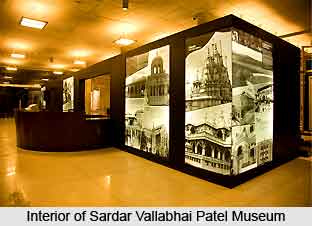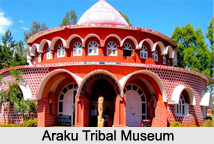 Sardar Vallabhai Patel Museum is situated in Sonifalia area of the city of Surat, in Gujarat. A small statue of Sardar Vallabhai Patel is placed at the gateway of this museum. An Indian flag, which was made by the members of Indian National Congress in 1930 to 1931, is one of the major attractions of this memorial, among several other objects. The three basic functions of Sardar Vallabhai Patel Museum are conservation, accumulation and exhibition of artefacts. The building is visited by the students of many educational institutes and boasts of about 8,507 specimens, which includes gifts and donations.
Sardar Vallabhai Patel Museum is situated in Sonifalia area of the city of Surat, in Gujarat. A small statue of Sardar Vallabhai Patel is placed at the gateway of this museum. An Indian flag, which was made by the members of Indian National Congress in 1930 to 1931, is one of the major attractions of this memorial, among several other objects. The three basic functions of Sardar Vallabhai Patel Museum are conservation, accumulation and exhibition of artefacts. The building is visited by the students of many educational institutes and boasts of about 8,507 specimens, which includes gifts and donations.
History of Sardar Vallabhai Patel Museum
Sardar Vallabhai Patel Museum is located in `Moti Shahi Mahal`, which was built in the period spanning 1618 to 1622, by Shah Jahan, a Mughal emperor. During the time of construction of this historical building, he was the governor of Gujarat. It is said that the architecture of this palace inspired Shah Jahan to construct the famous monument, `Taj Mahal`. Nobel laureate and Bengali poet Rabindranath Tagore had once resided in the Moti Shahi Mahala in 1878. It was in this palace that he composed his very first song and also a ghost story named, `The Hungry Stones`.
In 1890, Sardar Vallabhai Patel Museum was known as Winchester Museum, named after the then collector of Surat, Mr.Winchester. Sardar Vallabhai Patel Museum was organised by this gentleman, near Victoria Garden, which was also referred to as Ranibaug Garden. During that period, the museum comprised only a single hall consisting of some collections of sandalwood, `zari` work, metal crafts and wooden materials. However, with the passage of time, the museum achieved greater heights of cultural status due to the support of some charitable gentry.
Moti Shahi Mahal was later administered by British government officials during British Raj. After India gained independence from British regime, the palace became `Raj Bhavan`, where the Governor of Gujarat resided, from 1960 to 1978. In the year 1975, the governor of Gujarat ordered for the installation of a memorial to honour Sardar Vallabhai Patel on his 100th birth anniversary. The museum was established on 7th March, 1980.
A brand new series of historical artefacts were introduced in Sardar Vallabhai Patel Museum in the year 1987. Postal stamps of the Indian post independence period were an added attraction in the museum. Both these galleries, which attract tourists from across the world, besides school students and college students, are completely air-conditioned.
 Attractions of Sardar Vallabhai Patel Museum
Attractions of Sardar Vallabhai Patel Museum
Sardar Vallabhai Patel Museum contains various antique objects belonging to the Mughal regime and the British Raj in India. Terracotta, sandalwood, porcelain, wooden materials, stone artefacts, ivory, miniature paintings, oil paintings, and various forms of textiles and manuscripts are preserved in Sardar Vallabhai Patel Museum. The ground floor of the museum possesses several exhibits dedicated Sardar Sarovar Project, a project of hydroelectric power plants and dams on the river valley of Narmada, which includes the Indian states of Gujarat, Madhya Pradesh and Maharashtra. Books, statistics, graphics, pictures and other intricate details of this project are displayed in this section.
Sardar Vallabhai Patel Museum also contains books, pictures, portraits, statues, busts and other items which are memorials of Mahatma Gandhi. Gandhi`s association and friendship with Sardar Patel is portrayed deeply throughout the length and breadth of the entire Museum. Pictorial representations and stories in the central hall and the four adjoining rooms of the building describe Vallabhai Patel`s connection with Mahatma Gandhi, and many other leaders of the Indian freedom movement. Caricatures and political cartoons obtained from newspapers during that time are also displayed there. The collection includes portraits of Sardar Vallabhai Patel, in which he appears with his friends and family members. The room which is located to the right of the main entrance has Sardar Patel`s accessories like slippers, shoes, `dhoti` and `khadi kurta`, jacket and a few European garments which he utilized during his youth.
The right wing of the palace, which is on the first floor, houses the room where Tagore had spent his time when he lived in that building. There is a statue of Rabindranath Tagore, besides his paintings, pictures, portraits and numerous other belongings in this room, which serve as memorials of this poet.
This Museum contains as many as 287 miniature paintings which portray the childhood pranks of Lord Krishna and `Okha Haran`, which were all donations of Navinchandra Kalidasa Bharatiya, the former Mayor of the area of Surat. Other significant gifts to the museum consisted of a writing desk with a joint book shelf, made of carved wood which belonged to Professor Chandabhai Amirud-din Muchhala, beautifully carved sofa sets of Dabhoiwal and wooden dressing tables which belonged to the British East India Company, among innumerable other items of interest. Rajendra C. Surkatha, who was the former director of the museum, had donated imitations of the paintings of Ajanta Caves, which were painted on clothes, along with a few of his self-drawn portraits. The porcelain objects in the museum had been loaned by Tata Trust of Bombay (Mumbai). Various forms of sculptures and miniatures had been gifted by the National Museum located in New Delhi.
Unique objects of glassware, old books, stuffed animal toys and aquatic specimens like precious stones, conches, artefacts made of shells and minerals are exhibited in Sardar Vallabhai Patel museum. The museum remains closed on Mondays and holidays of Surat Municipal Corporation.


















